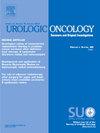术前或医源性透析依赖患者行根治性肾输尿管切除术的肿瘤和生存预后。
IF 2.3
3区 医学
Q3 ONCOLOGY
Urologic Oncology-seminars and Original Investigations
Pub Date : 2025-08-05
DOI:10.1016/j.urolonc.2025.06.020
引用次数: 0
摘要
目的:根治性肾输尿管切除术(RNU)是治疗高危上尿路上皮癌(UTUC)的金标准。然而,RNU提供的肿瘤控制可能伴随着显著的肾功能下降。关于RNU后即刻终末期肾病(ESRD)患者的数据有限。在此,我们研究了手术前依赖透析或手术导致无肾的RNU患者的结果,并与匹配的对照队列进行了比较。材料和方法:我们查询了我们的多机构RNU数据库,以确定术前ESRD (n = 16)或孤立肾(n = 12)患者。我们根据年龄、性别、Charlson合并症指数、吸烟状况和病理t分期将这些1:2的RNU患者与对照队列进行匹配。使用Kaplan-Meier方法比较肿瘤和生存结果。结果:两组具有相似的基线临床和肿瘤特征,包括围手术期全身治疗的使用。在复发时间和癌症特异性死亡率方面没有显著差异。然而,透析队列显示出更高的总死亡率,3年和5年生存率分别为29%和14%,而对照组为60%和57% (HR 2.13, P = 0.03)。结论:与对照组相比,接受RNU并立即术后ESRD的患者具有相似的肿瘤预后,但总生存期更差。这些结果可能与ESRD和其他非肿瘤性合并症的影响有关,这必须考虑到治疗决策。对于那些最终选择RNU的患者,应尽一切努力优化手术后任何潜在的可逆合并症。本文章由计算机程序翻译,如有差异,请以英文原文为准。
Oncologic and survival outcomes in patients undergoing radical nephroureterectomy with preoperative or iatrogenic dialysis dependence
Purpose
Radical nephroureterectomy (RNU) is the gold standard treatment for high-risk upper tract urothelial carcinoma (UTUC). However, the oncologic control afforded by RNU may be accompanied by significant renal function decline. Data regarding patients with immediate end-stage renal disease (ESRD) after RNU is limited. Herein, we investigate outcomes of patients undergoing RNU who were dialysis-dependent prior to surgery or rendered anephric by surgery relative to a matched control cohort.
Materials and Methods
We queried our multi-institutional RNU database to identify patients with preoperative ESRD (n = 16) or solitary kidney (n = 12). We matched these 1:2 to a control cohort of RNU patients using age, sex, Charlson Comorbidity Index, smoking status, and pathologic T-stage. Oncologic and survival outcomes were compared using the Kaplan–Meier method.
Results
The two groups had similar baseline clinical and oncologic characteristics, including utilization of perioperative systemic therapy. There was no significant difference in time to recurrence or cancer specific mortality. However, the dialysis cohort displayed a higher risk of overall mortality, with 3- and 5-year survival of 29% and 14%, compared to 60% and 57% in the control group (HR 2.13, P = 0.03).
Conclusions
Patients undergoing RNU with immediate postoperative ESRD had similar oncologic outcomes but worse overall survival compared to matched controls. These results are likely related to the impact of ESRD and other nononcologic comorbidities, which must factor into treatment decisions. For those who ultimately elect RNU, all efforts should be made to optimize any potentially reversible comorbidities after surgery.
求助全文
通过发布文献求助,成功后即可免费获取论文全文。
去求助
来源期刊
CiteScore
4.80
自引率
3.70%
发文量
297
审稿时长
7.6 weeks
期刊介绍:
Urologic Oncology: Seminars and Original Investigations is the official journal of the Society of Urologic Oncology. The journal publishes practical, timely, and relevant clinical and basic science research articles which address any aspect of urologic oncology. Each issue comprises original research, news and topics, survey articles providing short commentaries on other important articles in the urologic oncology literature, and reviews including an in-depth Seminar examining a specific clinical dilemma. The journal periodically publishes supplement issues devoted to areas of current interest to the urologic oncology community. Articles published are of interest to researchers and the clinicians involved in the practice of urologic oncology including urologists, oncologists, and radiologists.

 求助内容:
求助内容: 应助结果提醒方式:
应助结果提醒方式:


